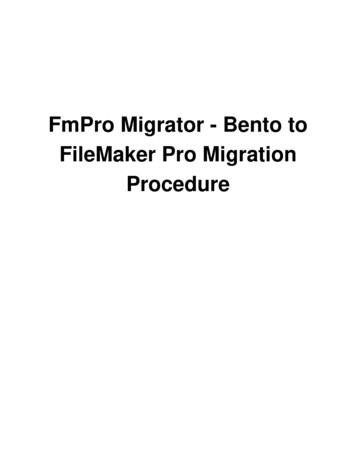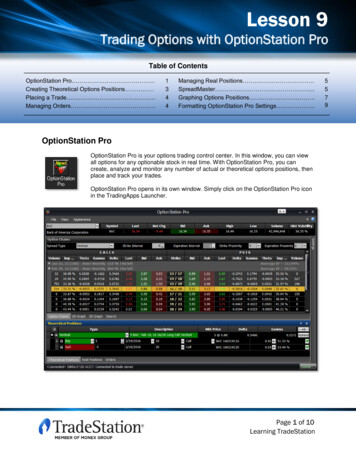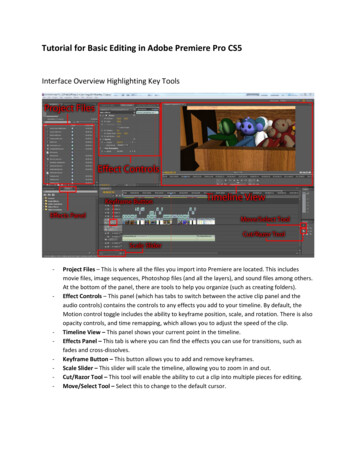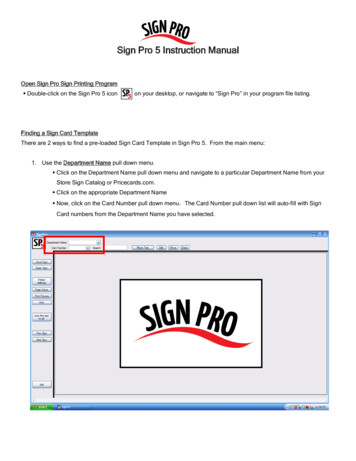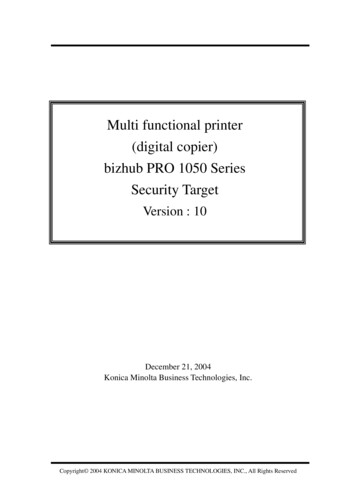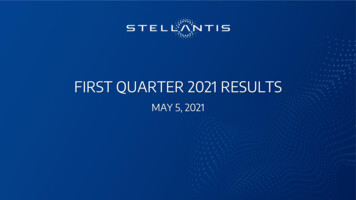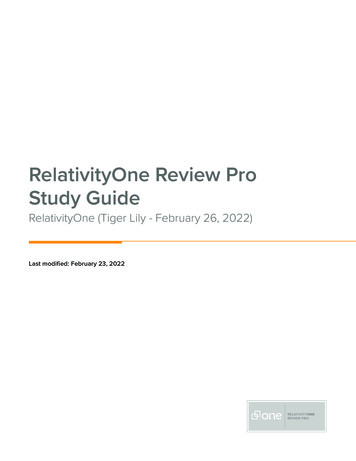
Transcription
RelativityOne Review ProStudy GuideRelativityOne (Tiger Lily - February 26, 2022)Last modified: February 23, 2022
ContentsExam Overview. 3Exam description. 3Study guide format. 3Study guide and exam updates. 3Exam Details. 4Exam Structure, Format, and Preparation. 5Study Resources. 6Navigating a workspace. 7Navigating the core reviewer interface. 9Working with batches. 10Reviewing documents using active learning. 11Coding documents. 12Applying markups. 13Working with views and dashboards. 15Using Analytics for review. 16Filtering and searching for documents. 18Exam Items. 20Content Distribution Disclaimers. 32Image Appendix. 33Change Log. 41 Relativity. All rights reserved.2
Exam OverviewThis document is designed to be a study guide for the RelativityOne Review Pro exam. Using this study guide, you cantake a deeper dive into the key points of Relativity review features and workflows, and prepare with exam questions andadditional resources.Exam descriptionThe RelativityOne Review Pro exam certifies knowledge of Relativity review fundamentals, workflows, and the Aero UI.This exam is designed for document reviewers, attorneys, paralegals, and end users who work hands-on in Relativity on aregular basis and want to validate their proficiency in Relativity review.Study guide formatThis study guide is divided into three parts: RelativityOne Review Pro Exam Details: This section contains information about the exam structure and format, andinstructions on how to prepare for the exam. Study Resources: This section is divided based on exam topics, with one section for each exam topic. Each sectioncontains key points and references to help further your knowledge of Relativity review features and process, and learnabout information about that topic specific to the RelativityOne Review Pro exam. Understanding the concepts andreferences mentioned in the Study Resources is crucial to both your work in review and successfully passing the exam. Exam Items: This section includes exam items and their corresponding study source. Use the study sources and thestudy resources (key points and references) to identify correct answers.Study guide and exam updatesThe RelativityOne Review Pro exam will remain up-to-date based on quarterly releases. Review the Exam Update Schedulefor upcoming exam changes. Plan accordingly when studying for the exam.To view changes made to the exam from one version to the next, review the Change Log. Relativity. All rights reserved.3
Exam Details
Exam StructureThe RelativityOne Review Pro certification helps document reviewers and contract attorneys certify their knowledge ofdocument review features and processes in Relativity. The exam tests on the RelativityOne Tiger Lily release fromFebruary 26, 2022 and is updated based on quarterly releases. Plan accordingly when studying for the exam.The following table outlines the various topics tested on the exam, along with their importance. Topic importancedetermines the number of questions you will receive in each topic. High importance topics include more questions, and lowimportance topics include fewer questions. High importance topics 14% of the quiz Medium importance topics 10-12% of the quiz Low importance topics 6-8% of the quizTopicImportanceNavigating the review interfaceHighCoding documentsHighWorking with views and dashboardsHighWorking with batchesMediumReviewing documents using active learningMediumUsing Analytics for reviewMediumFiltering and searching for documentsMediumNavigating a workspaceLowApplying markupsLowExam FormatThe exam contains a 50-question quiz covering the topics listed above. Question types include multiple choice, multipleresponse, true/false, matching, ordering, and hot spot. You will have 35 minutes to complete the quiz. You must achieve ascore of 80% or higher to pass.Exam PreparationThere are no prerequisites for this certification; however, in order to prepare, we recommend following: Read and understand this Study Guide. This guide contains the necessary materials to prepare for the exam, includingtopics, key points, resources, and exam items. Review the RelativityOne documentation. This is a free and useful resource for the exam. Familiarize yourself with the on-demand and live training content. We offer a variety of training resources to enhanceyour knowledge, which can be found on the Training Center. Relativity. All rights reserved.5
RelativityOne Review ProStudy Resources
Navigating a workspaceKey points When you review documents in Relativity, it’s important to understand several objects used in the document reviewprocess:ObjectDefinitionDocumentRecord within a workspace.WorkspaceSecure data repository in which documents are stored.FieldStores document metadata or coding decisions (ex. Responsiveness).ChoicePredetermined value that is applied to a field (ex. Responsive). It’s also important to understand how to navigate within a Relativity workspace:1. Favorite - Indicates whether a page is favorited. Click to add/remove a page from favorites.2. Quick nav - Use quick nav to quickly search for and navigate to any tab in Relativity that you have access to.3. Favorites menu - Contains all your favorites, and the last 10 pages in your browsing history (Recents).4. Avatar - Access your user menu options, including My Settings, Help, and Logout.5. View bar and Related Items drop-down - Use the drop-downs to change your view, or include related items in yourview.6. Document browser menu - Choose whether the browser displays folders or saved searches.7. Collapse icon - Click to reduce the widget of the Sidebar and only display the icon for each tab.8. All Tabs menu - Click to view all the tabs in the workspace that you have access to.9. Panel toggle icons - Change whether the browser, search panel, and/or document preview panel display. Relativity. All rights reserved.7
Reference materialsTraining video Aero for End Users OverviewDocumentation Aero Tab Navigation Quick Reference Guide Case Workspace Quick Reference Guide Relativity. All rights reserved.8
Navigating the Review InterfaceKey points The review interface displays workspace documents during review. Once you click on a document, it opens in thereview Interface. Once you open a document in the review interface, you can: Apply a coding decision to the document. Redact the document. View existing redactions and highlights in the document. View key terms that are highlighted in the document. The Relativity viewer is the part of the review interface that displays documents. You can use the viewer type tabs totoggle the loaded formats of documents. Some common viewer types you will use for review include: Native Viewer - You can view an HTML rendering of the document that is as close to the original version of thedocument as possible. You can search the text of the document, navigate through a document or document set, andzoom from the native viewer. Image Viewer - You can use the image viewer to highlight and redact documents. Long Text Viewer - You can use the long text viewer to view the extracted text of a document. The viewer also displays term highlighting, called persistent highlights, if it has been configured in the workspace by areview manager or admin. If a document you’re reviewing contains any of the terms specified in a persistent highlight set, the list of terms andthe number of times they appear in the document are displayed in the viewer.Reference materialsTraining video Aero for End Users OverviewDocumentation RelativityOne Review Interface Quick Reference Guide Reviewing documents in Relativity Viewer Relativity. All rights reserved.9
Working with batchesKey points Batching helps structure large scale review by organizing documents into groups, or batches, based on certain criteria.Batches are then assigned to members of the review team. Batches typically include entire document families, likeemails and their attachments, to help streamline review and avoid duplicative work.Batch workflow1. A batch set is created by a review manager or admin.2. Once a batch set is created, you can navigate to the review batches tab to check a batch out.a. Batches may also be assigned to you by other users.3. Once you review all the documents in the batch, you can check that batch in as Completed to signal you are done reviewing that set of documents.Using batches in review Batches can have one of three statuses. The status signals which batches still require review and may be checked out. Blank - The batch has not been checked out or reviewed by a user. In progress - The batch is checked out and has not yet been checked in. There may be some documents that havenot yet been reviewed. Completed - The batch has been checked in as completed, indicating all documents have been reviewed. If you are reviewing documents in a batch, your review manager or admin may create a view to help you keep track ofthe documents you have checked out in a batch. Some common views that are used in review are: My Checked Out Batch - This view displays any documents in your batches currently in progress. My Unreviewed Documents - This view displays documents that are in batches that are assigned to you that havenot yet been coded.Checking batches in You can check in your batch at any time after it’s been checked out. The option you select when checking the batch inindicates to other reviewers whether or not the review is complete. Check In As Pending - If a batch is checked in as pending, it will appear as having a blank status. You might chooseto check a batch in as pending if you have not finished reviewing all documents in the batch, but need to check thatbatch in so you can check out and begin reviewing documents in a different batch. Check In As Completed - Checks the batch in as completed. You should only check a batch in as completed if youhave reviewed all documents in the batch, but it is possible to select the Check In As Completed option even if not alldocuments have been reviewed. Reassign To - If you have the appropriate permissions, you can assign batches to other users.Reference materialsDocumentation Batches Assigning batches and checking batches in and out Relativity. All rights reserved.10
Reviewing documents using active learningKey points Active learning is a technology-assisted review tool that is used to help predict which documents are most likely to berelevant. Active learning continuously learns from a reviewer’s coding decisions, and can then serve up documents toreviewers based on the previous coding decisions applied.Active learning review workflow1. An admin or review manager configures an active learning project, and assigns you to an active learning review queue.2. Once you log in to your workspace, you have access to a view named after the active learning project.a. This view returns a list of all documents you have already reviewed or skipped in your active learning queue.b. When you access this view for the first time, no documents will appear because none have been coded yet. Documents start to appear in the list as you begin to code documents. Documents you skip also appear in this view.3. Click the Start Review button in the blue banner across the top of the view.4. Once you click Start Review, you can begin reviewing documents as you would in a linear document review. Codedocuments on the review field specified for the project, and click Save and Next to get a new document.a. You can change coding decisions on documents you previously reviewed. You can access these documents andupdate the coding decision from your active learning project view.5. After you code a document and save the coding decision, the document is ranked as a measure of its relevance. Adminsuse these document rankings to determine how many relevant documents exist in the set, and when review is complete.Active learning best practices for reviewers Four Corners Test: When you review a document and are trying to determine if it meets the criteria for responsiveness,remember to only use the extracted text of the document, within the “Four Corners” of the document, to determineresponsiveness. Ask yourself: Is the information that makes this document responsive contained within the four cornersof the document’s face? Common scenarios which violate the Four Corners Test, and therefore should not be codedresponsive, are:- A document that comes from a custodian whose documents are usually responsive.- A document created within a date range that is presumptively responsive.- A document that is a family member of another document that is coded responsive. Skipping documents: You can skip documents without making a coding decision, unless the review field is required.Reference materialsDocumentation Active Learning Reviewer access Best practices for Active Learning review Relativity. All rights reserved.11
Coding documentsKey points Reviewers use layouts to code documents in Relativity. A layout is a coding form that contains fields (e.g. ResponsiveDesignation, Privilege Designation). Each field contains multiple choices. Depending on the field, you can code eachdocument with one or more choices. For example, you may be tasked with conducting a first pass review to code documents for responsiveness. To completeyour review, you are told to use the Responsive Coding layout (pictured below) to code documents on the Responsivefield. On the Responsive field, there are four choices available: Not Responsive, Needs Further Review, Technical Issue,and Responsive. This is a single choice field, meaning you can only select one value for this field. The Privilege field is a multi-choice field. This means you can select more than one choice for this field. It is important to code using the correct layout and field(s) as instructed by your review manager. If fields or choices youneed are not available, contact your review manager so they can update the document layout accordingly.Reference materialsTraining video Aero UI for End Users OverviewDocumentation Viewer Layouts Reviewing documents in Relativity Relativity. All rights reserved.12
Applying markupsKey points Markups are divided into two types: highlights and redactions. You can use redactions to conceal sensitive information in a document before that document is used in litigation. For example, if the documents you are reviewing contain sensitive information, like social security numbers orcredit card numbers, you may be asked to apply redactions to this information. These redactions are then burnedonto the document when it is produced, meaning this sensitive information will be concealed, and the document isadmissable. For this reason, it’s important to follow all redaction instructions very carefully.Applying markups to document images You can add markups to documents that contain an image using the Image Viewer. In some cases, it can be useful to review all markups applied to a document. In this scenario, you can use the MarkupNavigation pane to view all markups in a document.Applying markups to document natives You can use the Redact application to apply markups to native Excel files, PDF files, and document images. You can apply redactions using Redact manually on each document, or by using a Redact project to apply redactionsautomatically based on words and terms you specify.Adding manual markups to Excel files Using Redact, you can apply markups to specific parts of a native Excel file including the sheet names, charts, objects,headers and footers right from the viewer. Relativity. All rights reserved.13
You can use the Redact Markup Navigator card in the viewer to easily redact specific areas of a native Excel documentsuch as charts, comments, headers, footers, and other embedded objects. To redact the name of a sheet within an Excel file, you can use the Redact Current Sheet Name button in the viewer. To redact a single column, select the column header you wish to redact, right-click and select the type of redaction you’dlike to apply.Reference materialsDocumentation Markups RelativityOne Review Interface Quick Reference Guide Redact Redact - Manual markups with Excel files Relativity. All rights reserved.14
Working with views and dashboardsKey pointsViews A view is a customizable list of items in Relativity, often created by a review manager or admin, from which a reviewercan sort and filter to locate specific items. Any time you see a list of documents in Relativity, you are using a view. Often, an admin will create a view to display only documents in your checked-out batches. This helps you organizeyour review, and ensure you are only seeing the documents necessary for your review. Views control three things: The items displayed on the list, based on a set of criteria.- For example, if an admin is creating a view to help you conduct first pass review more efficiently, they may chooseto configure the view to only display documents in your assigned batches. The fields of information displayed for the returned documents.- For example, if you are coding documents for responsiveness, your view may include fields such as ResponsiveDesignation, Custodian, and date fields that are relevant to help you determine whether or not a document isresponsive. The sort order of the returned items.- For example, an admin may configure a view to sort documents by custodian, so you can review all documents inthe set by a single custodian sequentially. You can also use any field in the view to sort your entire document set. An arrow appears next to the field name toindicate a sort is applied. If you are unable to access a view, or your view is returning unexpected results, check to see if you have any filtersapplied to your document list, and confirm what documents your view is configured to return. Filters and view conditionscould affect which documents are returned in your view.Dashboards A dashboard is a saved page configuration that can include a document list and widgets. Your review manager or admin may configure a dashboard with various widgets to help you visualize the types ofdocuments in your set, or to help you QC your work before completing a batch. Pivot widgets help you visualize the type of documents contained in your set. You can use widgets to help you filter yourdocument set to identify specific items. For example, on a pie chart widget, you can hover over a specific slice of the pie to view specific details about thatitem. You can then click the slice to filter for just documents that meet that criteria.Reference materialsDocumentation Views Dashboards Filters Workspace navigation Relativity. All rights reserved.15
Using Analytics for reviewRelativity Analytics helps to categorize documents, automate the review process, and make review more efficient. WhileRelativity Analytics includes a wide array of analytics tools, reviewers most frequently interact with the following analyticsfeatures, and as such, only the following topics are tested on the RelativityOne Review Pro exam.Key pointsEmail threading and email thread visualization (ETV) Email threading reduces the time and complexity of reviewing emails by gathering all forwards, replies, and reply-allmessages together. The email threading operation organizes emails into threads, which are single email conversationsthat start with an original email, and includes all of the subsequent replies and forwards pertaining to that email. For example, if a document set contains emails from multiple custodians, an admin may use email threading toarrange the email chain in order, typically including attachments, to make documents easier for you to review. There are two ways email messages can be categorized: Inclusive - an email that contains unique content not included in any other email, and therefore must be reviewed. Anemail with no replies or forwards, as well as the last email in a thread, are both considered inclusive. Non-inclusive - an email whose text and attachments are fully contained in another (inclusive) email. Email thread visualization (ETV) is a tool that exists in the viewer to help you visualize the entire thread for the emailyou’re currently viewing. You can use ETV to quickly see where the conversation branched, or where drafts orattachments occurred. You can also use ETV to help you QC your coding decisions. Using coding highlighting, you can see how emails in the current thread are coded for a particular field. Once youidentify coding discrepancies, you can use ETV to mass-update your coding decisions as needed.Textual near duplicate identification Textual near duplicate identification analyzes a document for exact syntax, word order, and word count, and groupsdocuments with similar text patterns together into relational groups. Once an admin runs textual near duplicate analysis,you can use this analysis to review a set of documents that are extremely similar, but not identical to each other. For example, you may be asked to ensure a series of very similar reports are coded the same way. In situations likethese, you can review textual near duplicates to ensure documents that are textually similar to each other are codedthe same way. A principal document is identified within a textual near duplicate identification group. The principal document is thelargest document in the duplicate group, and acts as the document to which all other documents in the duplicate groupare compared. Each document in the duplicate group is assigned a similarity. This is a percent value of similarity between the nearduplicate document and its principal document. A higher similarity score means the document is more similar to theprincipal document.Concept search Concept searching is a way to search for documents that have similar conceptual content to the submitted query.Using concept searching, you can submit a query of any size and return documents that contain the concept the queryexpresses. Instead of searching for a specific term, concept searching attempts to understand the semantic meaningand context of terms. The query and the resulting documents do not always share specific terms, but they do shareconceptual meaning. Relativity. All rights reserved.16
For example, if you run a concept search on a paragraph about university policies and guidelines, documentspertaining to teacher employment contracts may return. Even if the paragraph you submitted did not include the word“teacher” or the word “contract,” these documents are conceptually related to university policies, and can help youidentify correlations between documents, or identify communications that may have been intentionally obfuscated. Concept searching works best when run on more than just one word. When running a concept search, consider using asentence or paragraph that accurately and concisely describes the concept you’d like to search, like a paragraph fromthe case complaint.Find similar documents You can use the find similar documents tool in the viewer to identify documents that are conceptually similar to the entiredocument you are currently viewing. Just like concept search, find similar documents ranks other documents based on the conceptual similarity of thecontent, and not based on word count or order. However, instead of searching for a specific sentence or paragraph likeconcept searching, find similar documents submits the entire document as a search query. To find similar documents to the document you are currently viewing, click the View Similar Documents button at thebottom of the viewer. This opens the Similar Documents tab of the Document list pane, which displays conceptuallysimilar documents, along with their rank.Reference materialsDocumentation Email threading Inclusive emails Concept searching Using Email Thread Visualization in your QC workflows Find similar documents Relativity. All rights reserved.17
Filtering and searching for documentsThere are a variety of search features in Relativity designed to support a range of searching needs, from the most simple tothe most complex. While reviewers may use multiple types of searches, reviewers most frequently interact with the followingsearch features, and as such, only the following topics are tested on the RelativityOne Review Pro exam.Key pointsSearch panel You build and run searches on your document list by adding search conditions from the search panel. You can search onany fields you have access to, not just those currently visible in your view. You can access multiple search indexes from the search panel, including any Analytics and dtSearch indexes that areconfigured and accessible to you in your workspace. Any filters that you apply to the fields in your document list appear as cards in the search panel. You can drag and dropthese cards to reorder them, or drag one on top of another to create a logic group, which acts as a visual parenthesis foryour search query.Filters Filters are a quick and easy way to search for documents in your current document list view. Unlike using the searchpanel, in order to use filters to narrow down your document list based on a field, that field must be visible in yourdocuments view. The type of filter available for each field is determine by the field type.Using dtSearch indexes and syntaxNote: Only proximity syntax and auto-recognition of dates, emails, and credit cards are tested on the RelativityOne Review Proexam. In order to search using a dtSearch index, an admin or review manager must have already configured an index in yourworkspace, and provided you access. You can use dtSearch indexes to search for variations on a date, email, or credit card numbers, if this functionality isenabled on the dtSearch index. This can be especially useful if you’re working with documents that contain dates in bothUS and UK format, for example. Using dtSearch syntax, you can also conduct proximity searches. This can help you identify documents where one keyword occurs within a certain proximity of another word. For example, if you just search for documents that contain the word “contract,” your search results may beoverinclusive and cumbersome to review. However, if you search for documents that contain the word “contract”within five words of the word “fraud,” you can narrow down the document set to identify only the documents that aremost relevant to review. Relativity. All rights reserved.18
Reference materialsDocumentation Search panel Filters Using dtSearch syntax- Auto-recognition- Proximity syntax Searching Quick Reference Guide Relativity. All rights reserved.19
RelativityOne Review ProExam Items
Exam ItemsThis section includes all exam items on the RelativityOne Review Pro exam. You will receive 50 of the questions below onexam day. Each question has an associated study source. Use the study source to locate and identify the correct answer.In addition, some questions are hotspots, meaning you will be asked to click a location on an associated image to answerthe question. Images associated with hotspot questions are located in the Image Appendix. On exam day, you arepresented with each question and its corresponding image from the Image Appendix. You will use the associated image toanswer the question.In order to maintain the integrity of the exam, Relativity will not share or confirm answers to any of the questions.Note: Exam questions are subject to change without notice and in Relativity’s sole discretion. All question changes willbe reflected in the items below, as well as in the Change Log.Navigating a workspace1.6.Match the following terms to their definitions.TermDefinitionWorkspaceRecord within a workspace.ChoiceStores document metadata or codingdecisions.DocumentSecure data repository in whichdocuments are stored.FieldPredetermined value that is applied to afield.See Image Appendix - Image AStudy Source7.Where can you click to collapse the sidebar? (Click thelocation on the image.)See Image Appendix - Image AStudy Source3.Where can you click to access your user menu? (Click thelocation on the image.)See Image Appendix - Image AStudy Source4.Where can you click to see all tabs in your workspaceavailable to you? (Click the location on the image.)See Image Appendix - Image AStudy Source5.Where can you click to access your recently-viewed pages?(Click the location on the image.)Where do you click to open the saved searches browser?(Click the location on the image.)See Image Appendix - Image BStudy Source8.Where can you access the search panel? (Click the locationon the image.)See Image A
Oct 20, 2021 · Study guide format This study guide is divided into three parts: RelativityOne Review Pro Exam Details: This section contains information about the exam structure and format, and instructions on how to prepare for the exam. Study Resources: This section is divided based on exam t

